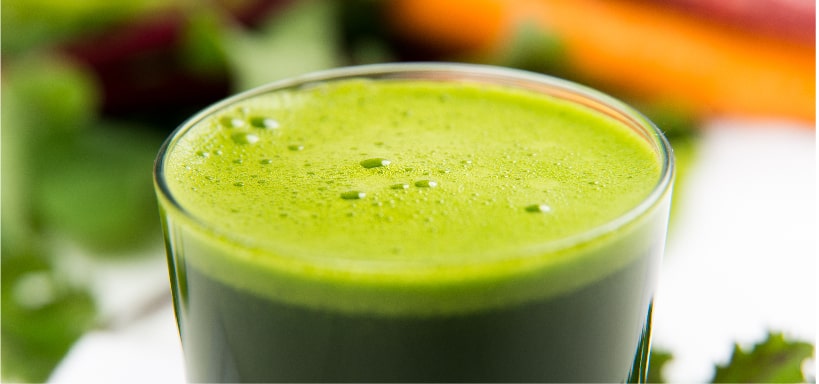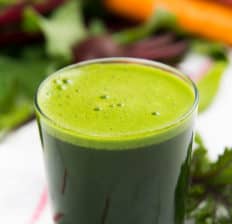Alkaline Juice Recipe

Alkalinity is important to our health because the cells in our bodies need to maintain their natural alkaline balance in order to stay healthy. Because of this, consuming alkaline foods can promote great overall health.
This alkalizing juice recipe incorporates high-alkaline foods like carrot, cucumber, cabbage, kale or spinach, lime and ginger. It’s also delicious and easy to incorporate into your diet.
What Is An Alkaline Diet?
An alkaline diet is one that is intended to help balance the blood pH level of the fluids in your body, including your blood and urine.
Achieving pH balance by eating an alkaline diet can be helpful in reducing morbidity and mortality from numerous chronic diseases and ailments — such as hypertension, diabetes, arthritis, vitamin D deficiency, and low bone density.
Unfortunately, many children and adults today consume a highly acidic, high-sodium diet that’s very low in not only magnesium and potassium, but also antioxidants, fiber and essential vitamins. On top of that, the typical Western diet is high in refined fats, simple sugars, sodium and chloride.
All of these changes to the human diet have resulted in increased “metabolic acidosis,” aka suboptimal pH levels. On top of this, many are suffering from low nutrient intake and problems such as potassium and magnesium deficiency.
Alkaline Juice Ingredients
An alkaline juice recipe should, of course, contain alkaline friendly foods. Fresh fruits and vegetables promote alkalinity the most.
Some of the best choices are mushrooms, citrus, dates, raisins, spinach, grapefruit, tomatoes, avocado, summer black radish, alfalfa grass, barley grass, cucumber, kale, jicama, wheat grass, broccoli, oregano, garlic, ginger, green beans, endive, cabbage, celery, red beet, watermelon, figs and ripe bananas.
Meanwhile, nearly all raw foods are on the alkaline menu, as uncooked fruits and vegetables are said to be biogenic or “life-giving.” Cooking foods depletes alkalizing minerals.
Lastly, drinks made from green vegetables and grasses in powder form are loaded with alkaline-forming foods and chlorophyll.
In this alkaline juice recipe below, you’ll note that it’s chockfull of pro-alkaline foods. Consume a few times a week, or at least once, to help your pH balance.
Print
Alkaline Juice Recipe
- Total Time: 3 min
- Yield: 1 1x
- Diet: Vegan
Description
This alkalizing juice recipe incorporates high-alkaline foods like carrot, cucumber, cabbage, kale or spinach, lime and ginger. It’s also delicious and easy to incorporate into your diet.
Ingredients
- 1 carrot
- 1 small cucumber
- ¼ head cabbage
- 1 cup kale or spinach
- ½ lime
- 1 knob ginger
Instructions
- Add all ingredients to vegetable juicer. Juice into the container, then pour into a glass.
- Stir juice together and consume immediately.
- Don’t have a juicer? Then add ingredients plus 6 ounces of water to a power blender. Blend and strain the fiber from the juice with fine wire mesh strainer!
- Category: Beverages
- Method: Blender
- Cuisine: American
Nutrition
- Serving Size: 6 oz
- Calories: 143
- Sugar: 14.5g
- Sodium: 135mg
- Fat: 1.1g
- Saturated Fat: 0.1g
- Unsaturated Fat: 0.3g
- Trans Fat: 0g
- Carbohydrates: 32.3g
- Fiber: 1g
- Protein: 5.4g
- Cholesterol: 0mg
Comments
Please keep comments under 200 characters.


🫚🍋🟩🥕🍎
❤️
Should the line be peeled first?
Love it
Why is it necessary to strain the fiber from the juice? I’m diabetic and it seems like it would be healthier for me to consume the whole veggies/fruits. I’ve never purchased a juicer because of this.
Some juicers allow for a minimal amount of fiber, plus you can put the fiber from the juiced fruits and veggies back in according to your liking
Carb is too HIGH!
We are all in! Thank you Dr. Axe!
How can this be so good for you with so many carbs, if you are diabetic.
Good question, Joyce. This recipe only has natural sugars from vegetables. The sugars in fresh veggies and fruit are not “free” sugars that diabetics should avoid. Free sugars are added sugars and those present in honey, syrups, nectars, fruit juice mixes, etc.
This is a very “down-to-earth” juice; all ingredients can be adjusted slightly to individual preference. Try it you’ll like it. ejh